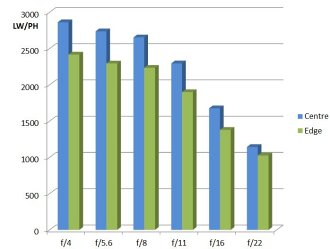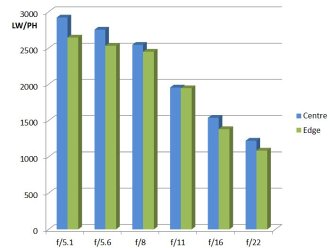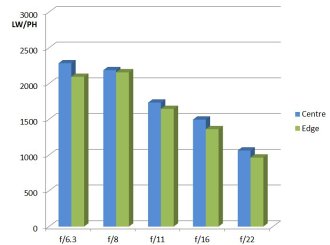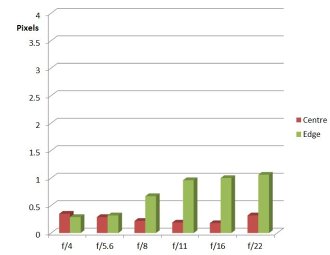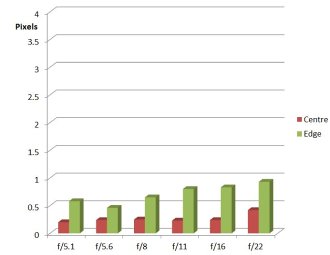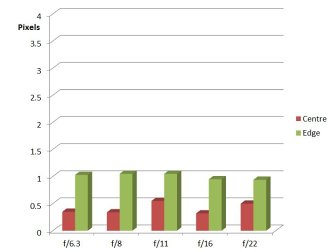Panasonic Leica DG Vario-Elmar 100-400mm f/4-6.3 Review
Panasonic Leica DG Vario-Elmar 100-400mm f/4.0-6.3 ASPH Performance
Theory tells us that a “perfect lens” would be at its sharpest wide open, with diffraction limiting performance as we stop down. This may not be a perfect lens in the literal sense, but its behaviour is rather like that when we look at sharpness. At all focal lengths, wide open is the sharpest aperture and this becomes limited by diffraction as we stop down.
At 100mm, the centre starts off at excellent levels that approach outstanding, maintaining this at one stop down and with the edges almost matching. Excellent at f/8, still very good at f/11 and dropping to fair levels at f/22.
At 200mm, wide open results are outstanding at the centre and almost matched one stop down. This excellent performance extends to f/8, after which sharpness slowly drops until f/22 is just fairly good. The edges follow the same pattern, albeit at a slightly lower level.
At 400mm sharpness is not quite so high, but overall remains very good, slowly reducing as we move from full aperture, showing a similar pattern to the shorter focal lengths. In summary, the lens has an excellent level of sharpness that is best at open aperture and one stop down. This is actually very useful, as images of distant subjects will often benefit from out of focus backgrounds (limited depth of field) and the fastest shutter speeds will help avoid subject movement.
How to read our charts
The blue column represents readings from the centre of the picture frame at the various apertures and the green is from the edges.The scale on the left side is an indication of actual image resolution as LW/PH and is described in detail above. The taller the column, the better the lens performance.
For this review, the lens was tested on a Panasonic Lumix GX8 using Imatest.
CA (Chromatic Aberration) is also well under control. The edges are slightly less well controlled than the centre, but still very good indeed. At 100mm centre CA is hovering below one third of a pixel, with the edges up to one pixel. A similar picture is seen at 200mm and slightly less so at 400mm. In use, CA was not evident in the images.
How to read our charts
Chromatic aberration is the lens' inability to focus on the sensor or film all colours of visible light at the same point. Severe chromatic aberration gives a noticeable fringing or a halo effect around sharp edges within the picture. It can be cured in software.Apochromatic lenses have special lens elements (aspheric, extra-low dispersion etc) to minimize the problem, hence they usually cost more.
For this review, the lens was tested on a Panasonic Lumix GX8 using Imatest.
Bokeh is almost always going to be subdued and pleasant in very long lenses and in this case the nine bladed diaphragm assists the optical design to deliver beautiful out of focus areas.
All of this would be in vain if camera shake takes the edge off sharpness, as it is normally bound to do. Even on a tripod, the image wavers about at 400mm and for the best results the self timer, set to 10 seconds, gives enough time for vibrations to settle. Without a tripod and switching on the OIS system, amazingly slow shutter speeds can be used. The image stabilises in the viewfinder very smartly and we can get away with perhaps 4 stops or more, depending on the individual photographer. At 400mm (800mm at 35mm-equivalent) normally at least 1/800 sec would be needed, but using IOS, 1/60 sec is possible. Of course, this does not help with subject movement.
I anticipated that a very compact design might mean a higher level of distortion, but actually the lens has as near to zero distortion as it's possible to get. Imatest measures very, very small amounts of barrel distortion, -0.00544% at 100mm, -0.0141% at 200mm and -0.0174% at 400mm. A superb result.
Finally, resistance to flare is also excellent. It is almost impossible to introduce image artifacts from internal reflections. The worst we see is a drop in contrast if the sun is just out of frame. Flare is not a problem in most situations.
Value For Money
The Leica DG Vario-Elmar 100-400mm f/4-6.3 Aspherical lens is priced at £1349, certainly not an insignificant amount. However, it now offers the longest focal length for MFT format along with a really excellent overall performance. The nearest MFT competitors are actually 300mm lenses, such as the Olympus 300mm f/4 recently reviewed, but that lens is actually more expensive at £2199.
The Nikon 200-500mm f/5.6E VR AF-S is a possible close match for Nikon users at £1179. For Canon there is the EF 200-400mm f/4 L IS USM at £8598. Pentax users would look to the HD Pentax-D FA 150-450mm f/4.5-5.6 as the nearest match at £1599.
Against this backdrop, it would seem the Panasonic lens is pretty unique in its class and reasonably priced for MFT users. It is still a large investment though, and a lens with fairly clear cut specialist applications.
Add your message
Please login here or if you've not registered, you can register here. Registering is safe, quick and free.
photodo Stats
428 MTF tests
74 in-depth photodo reviews
100+ users join each day
Help the lens community by reviewing or rating a lens today via our lens search
Latest Lens Reviews
- Chinon 28mm f/2.8 Vintage Lens Review
- Canon EF 70-200mm f/4L IS II USM Lens Review
- Samyang AF 85mm f/1.4 EF Review
- Sigma 70mm f/2.8 DG Macro Art Review
- Samyang AF 24mm f/2.8 FE Review
- Meike 50mm f/1.7 Review
- Tamron 70-210mm f/4 Di VC USD Review
- Lensbaby Burnside 35mm f/2.8 Review
- Asahi Super Takumar 50mm f/1.4 Review
- Asahi Super-Multi-Coated Takumar 135mm f/3.5 Review
